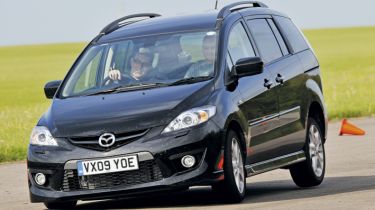Mazda 5
MPV
You expect high-performance cars to have strong brakes, but compact MPVs need to be able to stop without fuss, too.
As with off-roaders, people carriers have improved dramatically in terms of dynamics over the past few years, and the Mazda 5 is our class favourite. It is genuinely entertaining in corners, with excellent body control, sharp steering and communicative responses. It feels more like a sporty hatchback than an MPV.
This dynamic ability helped it record very impressive stopping distances when we tested it earlier this year. But how does it cope with our more extreme lane change trial?
A 36.7 per cent increase in distance between the straight-line and avoidance tests was the smallest rise among our contenders. There’s plenty of ABS kickback through the pedal in an emergency stop, but braking power is good, and once into the lane change, the Mazda’s positive turn-in and decent front-end grip helped it change direction smoothly.
As our dramatic pictures show, the nose pitches down more than in the BMW and Mercedes, and this weight transfer causes the rear end to go light. Combined with its positive turn-in, this makes the Mazda slide at the rear during the change of direction.
Used - available now

2024 Toyota
Aygo X
31,613 milesManualPetrol1.0L
Cash £10,909
2021 Toyota
Yaris Cross
15,123 milesAutomaticPetrol1.5L
Cash £23,601
2024 VOLKSWAGEN
CRAFTER
48,000 milesManualDiesel2.0L
Cash £19,990
2023 Tesla
Model 3
55,300 milesAutomaticElectric
Cash £17,495Fortunately, the car’s excellent body control and agile responses mean that corrective steering inputs quickly bring things back into line. Crucially, from Sport trim upwards, the 5 is fitted as standard with stability control, which reduces this tail slide during the avoidance test.
Even so, the Mazda required more driver skill to successfully complete the course and stop within the original lane than all of the cars here, bar the Ka.
In terms of stability, the heavier BMW and Mercedes coped better with changing direction and stopping at the same time, although the lighter Mazda pulled up two metres shorter than the big S-Class in the lane change.
Overall, the 5 impressed us with its braking ability, and it coped with extreme changes of direction very well for a vehicle in this class. Soggy suspension that allows lots of weight transfer is common to some MPV rivals, but the Mazda isn’t blighted in this way.
One negative is that, unlike the other cars in our test, the 5 doesn’t automatically switch on its hazards or flash its brake lights to warn drivers behind of your emergency deceleration.
Apart from that, the Mazda's technology is impressive, with electronic brake force distribution and brake assist both fitted as standard. This is a well engineered and practical family car that's a worthy member of our braking club.







